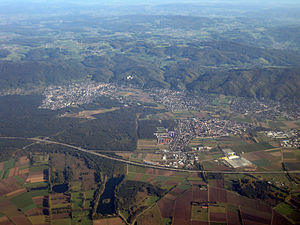Pfungstädter Moor
|
Pfungstädter Moor
|
||
|
The mountain road from the west, the Pfungstädter Moor can be seen at the bottom left. |
||
| location | Pfungstadt and Bickenbach , Darmstadt-Dieburg district , Hesse | |
| surface | 97 ha | |
| WDPA ID | 82330 | |
| Geographical location | 49 ° 46 ' N , 8 ° 36' E | |
|
|
||
| Setup date | January 10, 1955 | |
| particularities | shown again May 29, 1984, added October 31, 1994. | |
The Pfungstädter Moor is a 97.0 hectare nature reserve in the districts of Pfungstadt and Bickenbach in the Darmstadt-Dieburg district in the state of Hesse .
location
The “Pfungstädter Moor” nature reserve is located in the Hessian Rhine Plain - Central Neckarried area south of the city of Pfungstadt and northwest of Bickenbach. It was designated by ordinance of January 10, 1955, designated again on May 29, 1984 and the delimitations added on October 31, 1994. The protected area comprises three separate areas, one north and one south of the Erlensee and a small section between the railway line , the federal highway 5 and the state road L3303. The total area is about 97 hectares.
Protection purpose
By placing it under protection, a silted loop of the Altneckar river with a very well-preserved impact slope and remains of a moor as well as an alder forest should be preserved. These biotopes are to be secured as habitats for rare plants and animals.
history
The moor was created around 10,000 years ago when the Altneckar found its new bed near Heidelberg and the old river silted up and marshes and alder forests emerged. In historical times, peat was extracted in the Pfungstädter Moor and reeds were cut for various uses such as roofing or the production of straw mats. In 1955 the area was placed under nature protection. The renaturation as a moor was endangered, however, since the groundwater level sank constantly due to the drinking water pumping in the further and closer surroundings. In recent years, however, the moor has been prevented from drying out by supplying Rhine water using wind-powered pumping stations . Additional trenches ensure a more even distribution of the Rhine water fed into the moor.
Since 2007 the Pfungstädter Moor has also been part of the EU bird sanctuary Hessische Altneckarschlingen .
State 2011
In just a few years, the aforementioned measures have led to rare birds such as the reed warbler , bittern , pond warbler and other bird species adopting the created habitat.
Another special feature of the nature reserve is the occurrence of marsh lobed fern ( Thelypteris palustris) and pseudocyperus sedge ( Carex pseudocyperus) .
The jungle-like area is open to visitors and can be explored on the designated paths.
Directly to the north the area borders on the 7 hectare large Table Mountain, the former district garbage dump closed in 1986 . The landfill was created around 1950 in an eroded area of the moor. In 2004, the renaturation of the hill, which hides 850,000 cubic meters of garbage, was declared complete.
See also
Individual evidence
- ↑ a b map of the nature reserve. natureg.hessen.de, accessed on July 15, 2020 .
- ↑ a b Ordinance on the “Pfungstädter Moor” nature reserve of 29 May 1984. (+ Ordinance amending ordinances on nature reserves and nature and landscape protection areas in the Darmstadt administrative district of September 21, 1994. Article 4, p. 3098). PDF. State gazette for the state of Hesse, issue no. 25/1984, p. 1204, no. 604, accessed on July 15, 2020 .
- ^ New life in the moor in: FAZ from July 1, 2011, page 57
- ↑ Pfungstädter Moor nature reserve - the old Neckar bed. Accessed December 9, 2019 (German).
- ↑ From the garbage dump to Table Mountain .
Web links
- "Pfungstädter Moor" and Landbachaue. NABU Seeheim-Jugenheim, accessed on July 24, 2020 .
- Natura Trail "Pfungstadts Wilder East: From the dune to the moor". NaturFreunde Hessen eV, accessed on July 22, 2020 .




